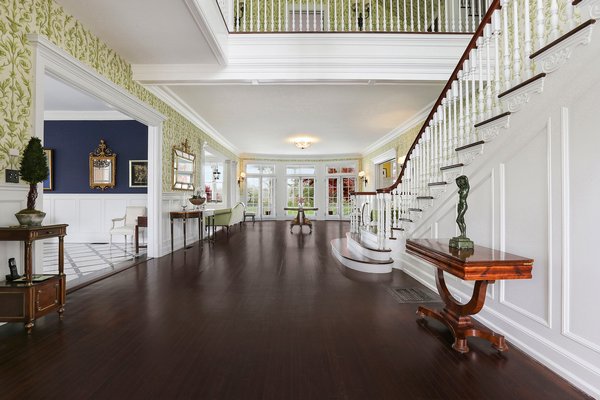
After an extensive three-year renovation, the Rose Manor House in Quogue is back on the market for a whopping $15.5 million.
Simon Rose, CEO of Dahlman Rose & Company, a boutique investment firm typically specializing in a peculiar mix of energy, metals, mining and transportation, bought the house back in 2010 for $5.4 million. At that price point, considering that the house had not seen any significant structural renovations since it was first commissioned in 1906 by the Greeff textile family, teardown seemed like the most economically viable option.
“Thank God that there are people around like Simon Rose who want to restore architecturally significant houses like these,” said Enzo Morabito, a broker for Douglas Elliman Real Estate, as he toured the house along with a film crew. The interior of the house—and the exterior of Mr. Morabito—can be seen by a national audience on NBC’s Sunday morning show “Open House NYC,” which features luxury homes from various high-end real estate pockets across the country.
Though Mr. Rose originally paid a hefty sum for an out-of-date structure, the current listing price would suggest that the renovations were as much a shrewd real estate play as they were a preservationist effort. It is “one of the last remaining examples of the extravagant ‘cottages’ of the Gilded Age,” said Mr. Morabito.
Visiting the house offers a reminder that the term “cottage” meant something entirely different in the first decade of the 20th century than it does today. If it wasn’t before, Rose Manor is now, indisputably, a palace. And a palace that has been “re-gilded” to match the new standards of opulence of a new “Gilded Age” in the Hamptons.
Situated on a sizable 3.4-acre lot in the pricey estate section of Quogue, Rose Manor boasts 15,700 square feet of interior space, 31 rooms, 11 bedrooms, 10 bathrooms, five fireplaces, a media room, and 17 unique heating/cooling zones. There is also a newly constructed 2,000-square-foot carriage house abutting the original structure, with room for six “luxury” cars, though one could assume it can house six average cars just as well.
Mr. Rose also brought a little bit of New York City to his manor: The sod in the garden is the same used in Yankee Stadium (Delea sod from Long Island), and the professional grade wi-fi is of comparable quality to what can be found at a Wall Street investment bank.
The property was previously known as “Belle Meade,” and Mr. Rose rebranded it “Rose Manor.” He “tore it apart piece by piece to re-create it to its former glory as intended by the famed architect, Stanford White,” said Mr. Morabito.
Mr. Rose acted as the general contractor, organizing a team of up to 90 local independent craftsmen to, among other projects, remove and reinstall all of the plumbing and electric.
According to the Douglas Elliman listing, 90 percent of all original woodwork was restored or exactly replicated, including original windows, decks and front columns.
The use of Stanford White to promote “Rose Manor” is intriguing: In fact, there is no official confirmation of the famed architect’s involvement in the design of the original house, but there are certain important features that at least suggest his influence, according to Mr. Morabito.
One is an inglenook, or chimney corner, a small recess adjoining a fireplace, creating an intimate space nearby that had been popular with prominent American architects. Another is the design of the staircase, which wraps around going toward the second floor. Third is the entryway, which allows the user to see straight through to the backyard, as a breezeway would.
“Bringing the inside out was one of White’s trademark themes,” Mr. Morabito said.
The house was completed in 1906—the same year the red-mustached architect was famously shot on the roof of Madison Square Garden by Harry Thaw after a long-standing vendetta. “The paperwork linking the house to Stanford White has disappeared,” Mr. Morabito said, “and it doesn’t make things easier that many people copied his style.”
Establishing a direct link to Stanford White is no matter for the Elliman brokers, who cite his name regularly in their materials. The name alone, it seems, carries with it enough tabloid intrigue that its mere mention trumps any need for definitive proof of association.
Aside from the potential Stanford White connection, the house has some other interesting history. In the 1970s, Eileen and Gerry Ford, founders of the Ford Model Agency, lived there and presumably had models frolicking on the grounds. Upstairs, they built “dorms” for visitors, who reportedly included Lauren Hutton, Beverly Johnson and Jerry Hall.
Mr. Rose retained this dormitory style in the servants’ quarters upstairs, but imbued it with his own circus motif.
The only hiccup is that the most expensive homes in Quogue, mostly directly on the ocean, top out at $10 million. When asked about the unprecedented listing price for a Quogue property off the ocean, Mr. Morabito said, “Last week, we had more than a hundred local brokers here to take a tour and survey the house. They universally agreed on the quality of the renovation and thought that our asking price was right on the money.”
Only time will tell if Rose Manor will achieve its high price point, but the house certainly meets the standards of comparable houses farther east that are nearing the $20 million mark. “If Rose Manor were in Southampton,” Mr. Morabito added, “we would be asking $30 million.”
While that may seem a little high, if you throw in a potential connection to a murdered philandering architect and supermodels, who knows?
On August 3 at 8:30 a.m., the interiors of Rose Manor can be seen by a national audience on NBC’s Sunday Morning program “Open House NYC.”